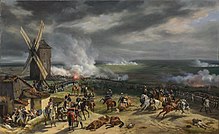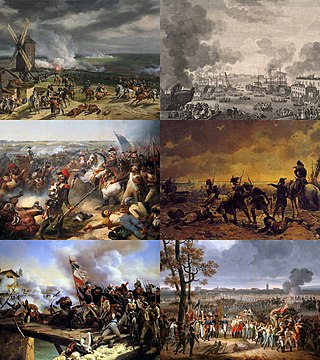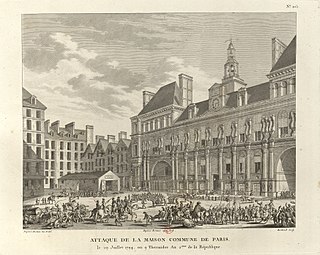| |||||
| Decades: | |||||
|---|---|---|---|---|---|
| See also: | Other events of 1792 History of France • Timeline • Years | ||||
Events from the year 1792 in France .
| |||||
| Decades: | |||||
|---|---|---|---|---|---|
| See also: | Other events of 1792 History of France • Timeline • Years | ||||
Events from the year 1792 in France .




The Reign of Terror was a period of the French Revolution when, following the creation of the First Republic, a series of massacres and numerous public executions took place in response to revolutionary fervour, anticlerical sentiment, and accusations of treason by the Committee of Public Safety. While terror was never formally instituted as a legal policy by the Convention, it was more often employed as a concept.

The 1790s was a decade that began on January 1, 1790, and ended on December 31, 1799. Considered as some of the Industrial Revolution's earlier days, the 1790s called for the start of an anti-imperialist world, as new democracies such as the French First Republic and the United States began flourishing at this era. Revolutions – both political and social – forever transformed global politics and art, as wars such as the French Revolutionary Wars and the American Revolutionary War moulded modern-day concepts of liberalism, partisanship, elections, and the political compass.

1792 (MDCCXCII) was a leap year starting on Sunday of the Gregorian calendar and a leap year starting on Thursday of the Julian calendar, the 1792nd year of the Common Era (CE) and Anno Domini (AD) designations, the 792nd year of the 2nd millennium, the 92nd year of the 18th century, and the 3rd year of the 1790s decade. As of the start of 1792, the Gregorian calendar was 11 days ahead of the Julian calendar, which remained in localized use until 1923.

1793 (MDCCXCIII) was a common year starting on Tuesday of the Gregorian calendar and a common year starting on Saturday of the Julian calendar, the 1793rd year of the Common Era (CE) and Anno Domini (AD) designations, the 793rd year of the 2nd millennium, the 93rd year of the 18th century, and the 4th year of the 1790s decade. As of the start of 1793, the Gregorian calendar was 11 days ahead of the Julian calendar, which remained in localized use until 1923.

Louis XVI was the last king of France before the fall of the monarchy during the French Revolution.

In the history of France, the First Republic, sometimes referred to in historiography as Revolutionary France, and officially the French Republic, was founded on 21 September 1792 during the French Revolution. The First Republic lasted until the declaration of the First Empire on 18 May 1804 under Napoléon Bonaparte, although the form of government changed several times.

The War of the First Coalition was a set of wars that several European powers fought between 1792 and 1797, initially against the constitutional Kingdom of France and then the French Republic that succeeded it. They were only loosely allied and fought without much apparent coordination or agreement; each power had its eye on a different part of France it wanted to appropriate after a French defeat, which never occurred.

The following is a timeline of the French Revolution.
The Girondins, or Girondists, were a political group during the French Revolution. From 1791 to 1793, the Girondins were active in the Legislative Assembly and the National Convention. Together with the Montagnards, they initially were part of the Jacobin movement. They campaigned for the end of the monarchy, but then resisted the spiraling momentum of the Revolution, which caused a conflict with the more radical Montagnards. They dominated the movement until their fall in the insurrection of 31 May – 2 June 1793, which resulted in the domination of the Montagnards and the purge and eventual mass execution of the Girondins. This event is considered to mark the beginning of the Reign of Terror.
The French Revolutionary Wars began on 20 April 1792 when the French Legislative Assembly declared war on Austria. This launched the War of the First Coalition.

The Paris Commune during the French Revolution was the government of Paris from 1789 until 1795. Established in the Hôtel de Ville just after the storming of the Bastille, it consisted of 144 delegates elected by the 60 divisions of the city. Before its formal establishment, there had been much popular discontent on the streets of Paris over who represented the true Commune, and who had the right to rule the Parisian people. The first mayor was Jean Sylvain Bailly, a relatively moderate Feuillant who supported constitutional monarchy. He was succeeded in November 1791 by Pétion de Villeneuve after Bailly's unpopular use of the National Guard to disperse a riotous assembly in the Champ de Mars.

The Revolutionary Tribunal was a court instituted by the National Convention during the French Revolution for the trial of political offenders. In October 1793, it became one of the most powerful engines of the period often called the Reign of Terror.

The Brunswick Manifesto was a proclamation issued by Charles William Ferdinand, Duke of Brunswick, commander of the Allied army, on 25 July 1792 to the population of Paris, France during the War of the First Coalition. The manifesto threatened that if the French royal family were harmed, then French civilians would be harmed. It was said to have been a measure intended to intimidate Paris, but rather helped further spur the increasingly radical French Revolution and finally led to the war between Revolutionary France and counter-revolutionary monarchies.

La Révolution française is a two-part 1989 historical drama co-produced by France, Germany, Italy and Canada for the 200th anniversary of the French Revolution. The full film runs at 360 minutes, but the edited-for-television version is slightly longer. It purports to tell a faithful and neutral story of the Revolution, from the calling of the Estates-General to the death of Maximilien de Robespierre. The film had a large budget and boasted an international cast. It was shot in French, German and English.
The following lists events that happened during 1794 in the French Republic.

The trial of Louis XVI—officially called "Citizen Louis Capet" since being dethroned—before the National Convention in December 1792 was a key event of the French Revolution. He was convicted of high treason and other crimes, resulting in his execution.

The Kingdom of France was a constitutional monarchy from 3 September 1791 until 21 September 1792, when it was succeeded by the French First Republic.
Pierre-Henri-Hélène-Marie Lebrun-Tondu was a journalist and a French minister, during the French Revolution.
Events from the year 1793 in France.